Glass vs Polycarbonate Greenhouses: Which Is Better?
When it comes to choosing a greenhouse, one of the first — and most important — decisions you'll face is the glazing material. Two of the most popular options in the UK are glass and polycarbonate. Both have their merits, but they offer very different benefits when it comes to light transmission, durability, insulation, and ease of use.
Glass has long been the traditional choice, favoured for its classic look and clear visibility. But in recent years, polycarbonate greenhouses have become increasingly popular among both beginner and experienced gardeners — and with good reason.
In this guide, we’ll compare glass and polycarbonate side by side, helping you understand the key differences and decide which is right for your garden.
Whether you're growing vegetables year-round or simply want a safe and practical space for nurturing plants, we'll explore why polycarbonate greenhouses are often the smarter, more versatile choice — especially in the unpredictable British climate.
Glass vs Polycarbonate Greenhouses: What’s the Difference?
Before diving into detailed comparisons, it helps to understand the fundamental differences between glass and polycarbonate as greenhouse materials. While both are transparent and allow light in, they perform very differently in real-world gardening conditions.

Glass Greenhouses
Glass has been the go-to glazing material for traditional greenhouses for decades. It’s typically available in two forms:
- Horticultural glass – standard 3mm thick glass, commonly used in entry-level greenhouses
- Toughened safety glass – stronger, heat-treated glass that shatters into blunt pieces if broken
Glass offers clear visibility and a classic aesthetic, which appeals to those wanting a more permanent, traditional garden feature. However, it’s also heavy, fragile, and offers limited insulation — which can be a challenge in the UK’s colder months.
Polycarbonate Greenhouses
Polycarbonate is a high-performance plastic material that’s rapidly gaining popularity in modern greenhouse construction. It’s usually sold as twin-wall polycarbonate, which consists of two layers with an air gap in between — creating a natural insulating effect.
Unlike glass, polycarbonate is:
- Lightweight
- Shatterproof
- UV-resistant
- Excellent at diffusing sunlight (which prevents plant scorching)
It may not have the same crystal-clear appearance as glass, but it more than makes up for it in terms of safety, practicality, and performance.
Comparing Light Transmission
Light is the lifeblood of any greenhouse — it fuels photosynthesis, keeps your plants growing strong, and affects everything from germination to flowering. So how do glass and polycarbonate measure up when it comes to letting in light?
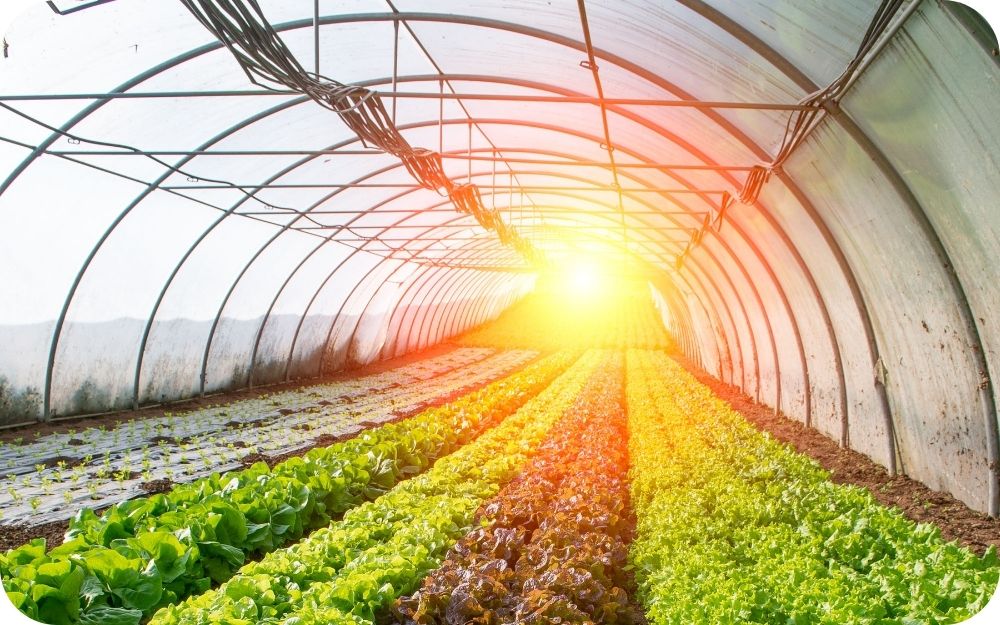
Glass: High Clarity, but Not Without Drawbacks
Traditional glass offers excellent light transmission, especially when it’s clean. It's clear, transparent surface allows sunlight to pass through almost unobstructed, which can be a real advantage in the duller months of the UK gardening calendar.
However, that same clarity can sometimes work against you. In summer, intense, direct sunlight can lead to scorching — particularly for delicate plants or seedlings. Glass also provides no natural light diffusion, meaning certain areas of the greenhouse may become overly bright or too warm, while others remain cooler or shaded.
This often results in the need for additional shading, blinds, or internal screens to create a more balanced growing environment.
Polycarbonate: Gentle Diffusion for Even Growing
Polycarbonate panels, particularly twin-wall varieties, naturally diffuse sunlight, scattering the light more evenly throughout the greenhouse. This helps prevent hotspots, reduces the risk of plant scorch, and creates a more stable, consistent environment — ideal for growing a wide range of crops.
While polycarbonate has slightly lower overall light transmission than glass (typically around 80–90% vs glass’s 90–95%), the quality of light is often better for plant health, especially during the warmer months. Plants receive gentler, more evenly distributed light, which promotes healthy growth and reduces the need for artificial shading.
So, Which Wins?
- If you’re after maximum clarity for display purposes, glass might have the edge.
- But if you want balanced light, less risk of scorching, and a more forgiving environment for your plants, polycarbonate is the smarter choice — especially in variable UK weather.
Durability and Safety
Greenhouses are exposed to the elements year-round — wind, rain, hail, falling branches, footballs… even the occasional wayward wheelbarrow. That’s why durability and safety should be at the top of your priority list when choosing a glazing material.
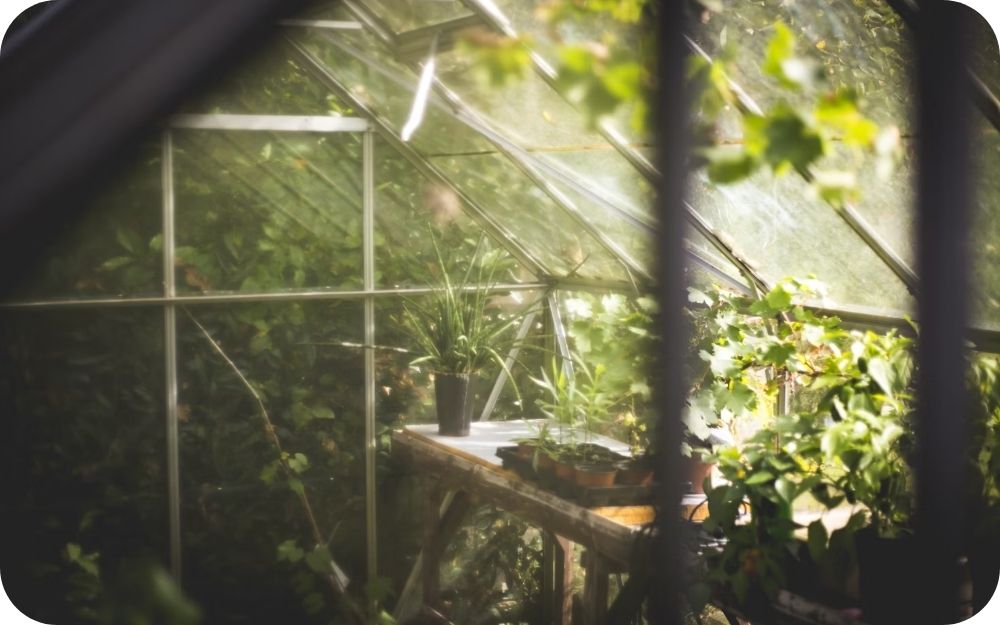
Glass: Traditional but Fragile
While glass offers a sturdy feel and elegant appearance, it’s also inherently brittle. Standard horticultural glass is particularly prone to cracking or shattering if struck, which makes it less than ideal for busy gardens, exposed locations, or homes with children and pets.
Toughened safety glass is a more resilient option. It’s around five times stronger than standard glass and, if broken, it crumbles into small blunt pieces rather than sharp shards — a much safer outcome. However, it’s still heavier, more expensive, and can be tricky to replace if a pane does break.
Polycarbonate: Lightweight, Tough and Shatterproof
Polycarbonate is built to take a beating. It’s impact-resistant, shatterproof, and can withstand knocks and bumps that would easily crack or break glass. This makes it ideal for:
- 🍃 Windy or exposed gardens
- 👪 Family gardens with kids or pets
- 🏫 Schools, community gardens, and shared spaces
Because it’s much lighter than glass, polycarbonate is also easier to handle and install — and less prone to injury during assembly or maintenance.
Its flexibility gives it another advantage: during high winds or accidental bumps, it has a little “give” rather than cracking under pressure.
The Verdict on Safety
If you’re after peace of mind, especially in a practical family garden or allotment, polycarbonate is the clear winner. It offers strength without the weight, and safety without the risk.
Insulation and Year-Round Growing
In the UK, where the weather can swing from warm sunshine to sudden frost within a day, maintaining a stable growing environment is key. Whether you’re starting seedlings early in spring, extending your harvest into autumn, or protecting tender plants over winter, insulation becomes essential.
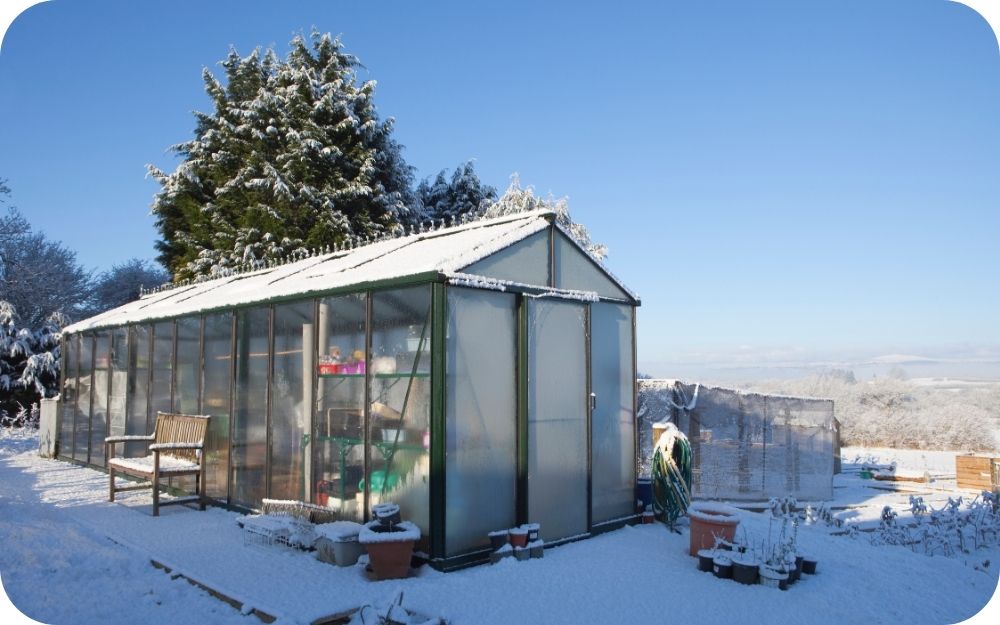
Glass: Low Insulation, Quick Heat Loss
Standard horticultural glass provides very little insulation. While it lets in plenty of light, it also allows heat to escape quickly — especially overnight or during colder months. This can make it challenging to maintain consistent temperatures inside the greenhouse without relying on electric heaters or additional insulation like bubble wrap.
Toughened glass performs slightly better in terms of strength and durability, but offers only marginal improvement when it comes to insulation.
As a result, glass greenhouses tend to lose heat rapidly, making them less efficient for year-round growing — and more expensive to heat if you plan to garden through winter.
Polycarbonate: Built-in Thermal Efficiency
Thanks to its twin-wall construction, polycarbonate acts a bit like double glazing. The air gap between the two layers helps trap heat inside the greenhouse, providing a natural insulating effect that keeps temperatures more stable — especially overnight and in colder seasons.
This means:
- Less need for artificial heating
- Lower energy costs if you do use a heater
- Better protection for plants during temperature dips
- A more forgiving environment for early sowing and late-season crops
It’s one of the key reasons why polycarbonate is such a popular choice for gardeners looking to get the most out of their greenhouse year-round — not just in summer.
The Bottom Line?
If you’re serious about extending your growing season, reducing heat loss, and creating a more energy-efficient greenhouse, polycarbonate is the superior option.
Weight and Installation
Ease of installation might not be the first thing you think about when shopping for a greenhouse — but once it arrives, you'll be glad you considered it. The weight and handling of your chosen material can have a big impact on setup time, safety, and even where you can position your greenhouse.
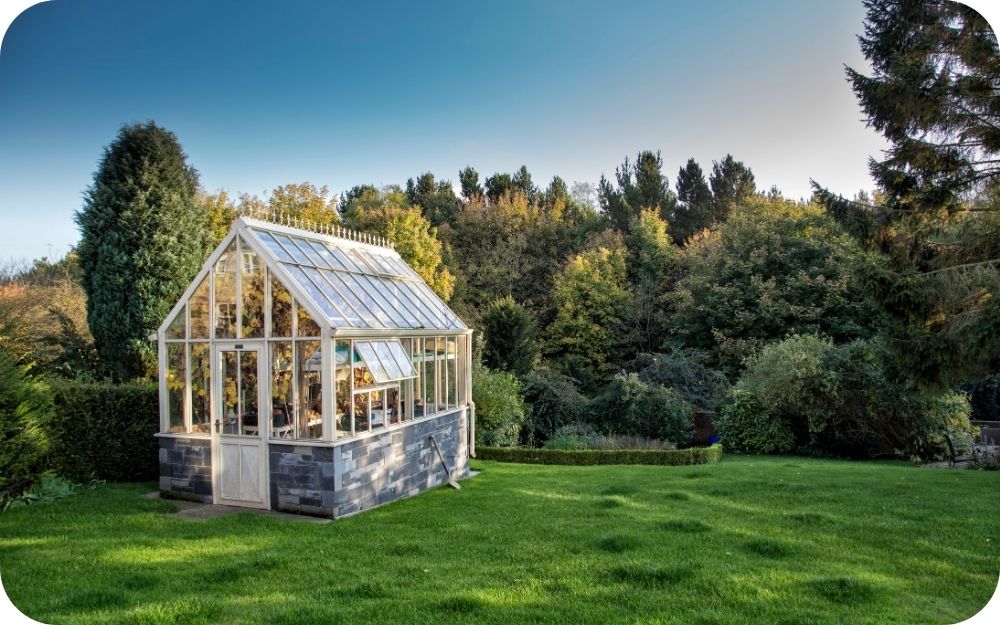
Glass: Heavy, Delicate, and Delivery-Dependent
Glass greenhouses — especially those made with toughened safety glass — are significantly heavier than polycarbonate models. Each panel needs careful handling to avoid breakage, which makes assembly more time-consuming and potentially hazardous if you’re attempting it yourself.
The added weight also means glass greenhouses usually require:
- A stronger frame and foundation
- Two or more people to install safely
- More careful planning for transport and positioning
Glass is also more expensive and challenging to ship, which is one of the reasons we don’t offer glass greenhouses at GardenFurnitureSets.co.uk — too many breakages in transit, and too many headaches for customers.
Polycarbonate: Lightweight and User-Friendly
In contrast, polycarbonate panels are lightweight, flexible, and easy to handle, even for one person. This makes assembly far less intimidating — particularly if you're tackling the project yourself or have limited help.
Benefits include:
- Quicker installation with less risk of injury
- Easier to position, even in tighter spaces or awkward garden layouts
- Less need for heavy-duty foundations or supports
- Lower delivery risk and typically cheaper shipping
It’s ideal for DIY gardeners or anyone who wants a straightforward, stress-free setup.
Why It Matters
Whether you're setting up your first greenhouse or replacing an older model, polycarbonate makes the process smoother from delivery to final bolt — without compromising on performance.
Maintenance and Longevity
A greenhouse isn’t just a one-season purchase — it’s an investment you’ll use for years to come. That’s why it’s important to consider how much ongoing care each material needs, and how well it holds up over time in the unpredictable UK climate.
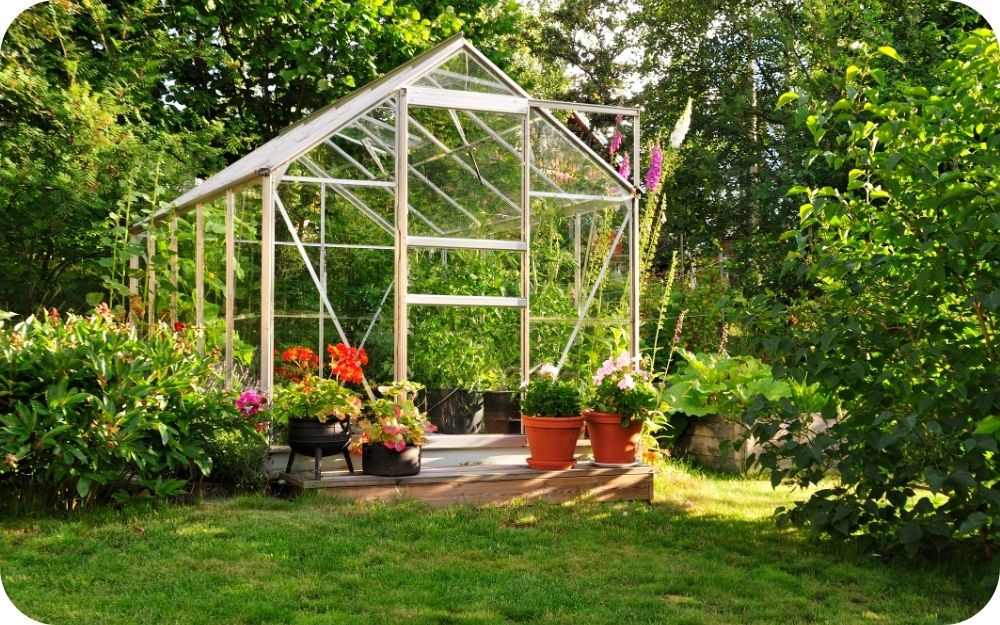
Glass: Long-Lasting, But Labour-Intensive
Glass is known for its durability — it won’t warp or discolour over time, and with proper care, it can last for decades. However, keeping it clean is a constant job. Algae, grime, and limescale can quickly build up, reducing light levels and affecting plant health.
You’ll need to:
- Clean panels regularly, especially after autumn and winter
- Watch for mould in damp corners or frame joints
- Carefully replace cracked panes if any damage occurs
Replacement glass panels can also be expensive and tricky to source in the right size — not ideal if you need a quick fix during the growing season.
Polycarbonate: Low-Maintenance and Built to Last
Polycarbonate panels are incredibly resilient and low-maintenance, making them perfect for busy gardeners. They’re treated with a UV-resistant coating, which protects against discolouration and brittleness over time, even with daily exposure to sun and rain.
Routine maintenance is simple:
- A quick wash with soapy water to remove dust or debris
- Occasional checks to ensure panels remain secure in the frame
- No worrying about breakage or replacing fragile panes
While polycarbonate may not last quite as long as toughened glass in ideal conditions, in real-world garden use, it often proves more durable — especially when you factor in fewer breakages and far less upkeep.
Which Lasts Longer?
- Glass may technically have a longer potential lifespan — but it comes with higher maintenance and replacement costs.
- Polycarbonate offers years of trouble-free use, with minimal upkeep and better overall reliability in everyday settings.
For most UK gardeners, polycarbonate delivers better value and fewer headaches over time.
Cost Considerations
Budget is a key factor for most greenhouse buyers — especially if you're new to gardening or looking for the best value. While both glass and polycarbonate greenhouses come in a range of price points, there are some clear differences when it comes to upfront cost, delivery, and long-term value.
Glass: Higher Upfront Costs and Hidden Expenses
Glass greenhouses — particularly those using toughened safety glass — tend to sit at the higher end of the price range. Beyond the cost of the structure itself, you’ll often need to factor in:
- Stronger frames to support the weight of glass
- Professional installation if you’re not comfortable handling fragile panels
- Higher delivery charges due to weight and breakability
- Replacement costs if panels are damaged in transit or over time
These added expenses can make glass greenhouses a significant investment — and not always the most practical one for everyday gardeners.
Polycarbonate: Better Value, Lower Hassle
Polycarbonate greenhouses are typically more budget-friendly, both upfront and over time. They’re lighter, which means:
- Lower shipping costs
- Easier DIY installation (no need for paid help)
- Fewer replacement costs thanks to their shatterproof design
And because polycarbonate retains heat better, you may also save money on winter heating if you plan to grow year-round.
While you might find the occasional bargain-priced glass model, polycarbonate generally offers better long-term value, especially for practical use in UK gardens.
Final Word on Cost
If you’re after a low-maintenance, affordable greenhouse that performs well in all seasons and doesn't come with hidden headaches, polycarbonate gives you more for your money — and fewer surprises down the line.
Which Is Right for You?
Choosing between glass and polycarbonate ultimately comes down to your priorities — aesthetics, performance, safety, and budget all play a part. Both materials have their strengths, but they suit different types of gardeners.
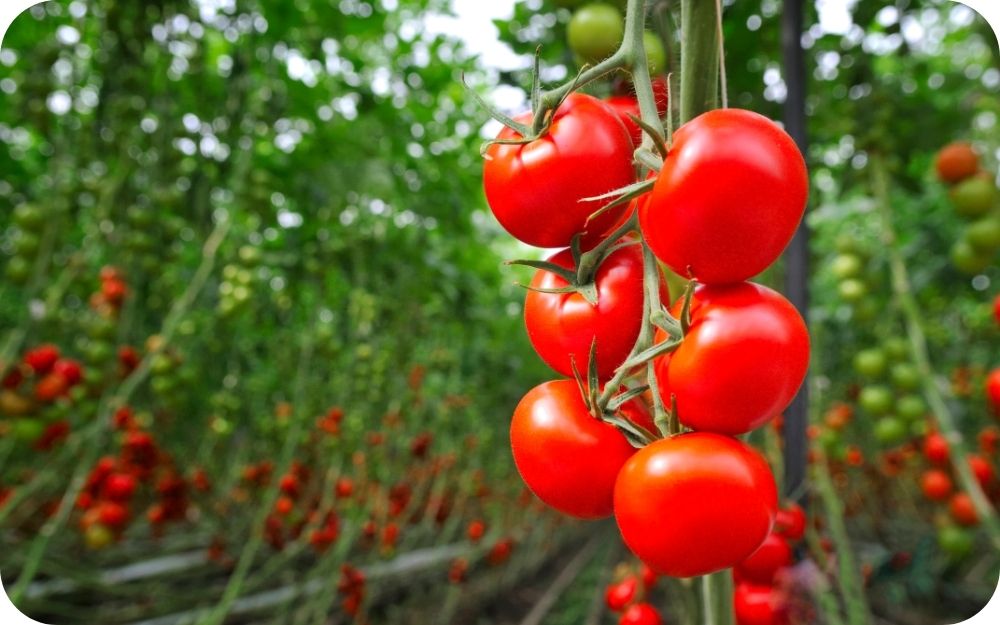
When Glass Might Be Worth Considering
If you're after a traditional look, want your greenhouse to be a permanent fixture in a formal garden, and are comfortable with a bit more maintenance (and cost), glass — particularly toughened safety glass — can be a beautiful option.
However, it’s important to go in knowing it’s heavier, more fragile, and less energy efficient, especially during colder months.
Why Polycarbonate Is the Smarter Choice for Most Gardeners
For the majority of UK gardeners — especially hobbyists, families, or those new to greenhouse growing — polycarbonate ticks all the right boxes:
- Shatterproof and safe for pets and children
- Lightweight and easy to install
- Naturally insulating, keeping heat in and costs down
- Diffuse light that helps prevent scorching
- Lower maintenance with excellent durability
Whether you’re growing vegetables, propagating seedlings, or experimenting with year-round crops, polycarbonate offers a reliable, user-friendly, and affordable greenhouse solution — without compromising on performance.
Final Thoughts
When it comes to choosing between glass and polycarbonate greenhouses, there’s no one-size-fits-all answer — but for most modern gardeners, polycarbonate offers the perfect blend of performance, safety, and value.
It’s lighter, tougher, and better suited to the UK’s changing weather. It keeps your plants warmer in winter, protects them from scorching in summer, and gives you peace of mind year-round. Whether you're just getting started or looking to upgrade an old greenhouse, polycarbonate is a smart, practical choice that fits seamlessly into busy lives and real-world gardens.
At GardenFurnitureSets.co.uk, we stock a wide range of polycarbonate greenhouses designed for UK gardens of all shapes and sizes — with easy delivery, simple assembly, and exceptional value.
👉 Browse our full range of greenhouses and start growing with confidence.




